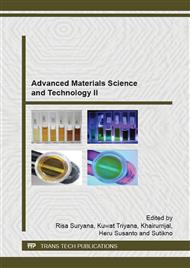p.140
p.147
p.151
p.155
p.160
p.164
p.169
p.173
p.177
Preliminary Study on the Biocompatibility of Stainless Steel 316L and UHMWPE Material
Abstract:
Stainless steel AISI 316L (SS316L) and ultra-high molecular weight polyethylene (UHMWPE) are widely used materials for artificial hip joint components. The SS316L material is typically used for the acetabular cup, femoral head and the stem, while the UHMWPE material is used for the acetabular liner in an artificial hip joint. The aim of this work is to study the biocompatibility of SS316L and UHMWPE materials by implanting and installing these materials in the tissues of rabbits. The tissues around the implants were examined after eight weeks of the installment. Results showed that the reaction of the rabbit tissues around the implants was positive. It was concluded that the SS316L and the UHMWPE materials are biocompatible and the applications of these materials for implants seems conceivable.
Info:
Periodical:
Pages:
160-163
Citation:
Online since:
August 2015
Authors:
Keywords:
Price:
Сopyright:
© 2015 Trans Tech Publications Ltd. All Rights Reserved
Share:
Citation:


